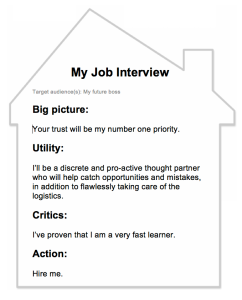Message Houses are not only for businesses or non-profits. They’re also useful in personal and private situations. They can help whenever you want to get somebody to do something: the cop to let you go without a speeding ticket; your girlfriend to accept your marriage proposal; a potential boss to hire you for a job.
 Let’s assume you’re applying for a job as an executive assistant. You made it through the initial screening. Now you’re getting ready for your job interview. What might your Message House for that encounter look like?
Let’s assume you’re applying for a job as an executive assistant. You made it through the initial screening. Now you’re getting ready for your job interview. What might your Message House for that encounter look like?
The audience is clear: It’s the hiring manager who will be interviewing you.
The [tooltip tip=”The Action Message tells your audience what to do.”]Action Message[/tooltip], obviously, is: “Hire me.”
So what’s your [tooltip tip=”The Utility Message conveys what’s useful.”]Utility Message[/tooltip] for why you should be hired? What are the benefits for your future boss? Look at it from her or his point of view. A great executive assistant enables a boss to work as efficiently as possible. He or she flawlessly takes care of the daily mechanics of office life (scheduling meetings, taking calls, planning travels). But a truly great executive assistant will do more than this. He or she will be a discrete thought partner, helping the boss catch opportunities and mistakes. So a great Utility Message might be something like: “I’ll take care of the logistics; plus I’ll be a discrete but pro-active thought partner who will help catch opportunities and mistakes.”
So what’s the [tooltip tip=”The Big Picture Message conveys why something matters in the larger scheme of things.”]Big Picture Message[/tooltip]? It should involve a larger, more universal notion. Something emotional. How about: “Your trust will be my number one priority.” That includes everything you promise in the utility message, but wraps it inside an idea of a higher order. Trust is an emotional and practical prerequisite in the relationship between an executive assistant and a boss; actually, it’s essential in any relationship. So this is a great Big Picture Message to use.
So what’s the [tooltip tip=”The Critics Message disarms the most likely concern.”]Critics Message[/tooltip]? That depends on where your biggest weakness lies. Do you have too little or too much experience? Have you never worked in the area before? Are you a convicted felon? Whatever it is, look at it from the other person’s perspective, and think of a way to disarm the criticism with a positive message. Let’s assume you’re applying for a job in a field that you have no experience in. A good critics message would be: “I’ve proven that I am a very fast learner.” You’ll need good proof points for this, for instance a story about how you quickly attained a lot of knowledge in a new area. With all these messages, it’s important that you are honest and authentic.
Now download the Message House template from this Web site, put your messages inside and tell yourself: “I’ll succeed if I stay inside my Message House”.
Look at your Message House before you go to sleep the night before. Put it under your pillow. Look at it again when you get up in the morning. Put it in the back pocket of your pants and look at it one more time just before you interview. Remember, you don’t have to use the messages verbatim. Don’t sound like a robot. Simply infuse what you say with your messages.
You’ll have maximized your chances for success!
You can download both, the sample Job Interview Message House shown left, and the Message House Word template to create your own Message Houses.
Remember: Stay inside your Message House and you will succeed!
Good luck!
About the Message House Method:
Message Houses are a remarkably easy but incredibly effective communications framework. Ultimately, they are about getting an audience to take a desired action. Their ease of use also makes them a great way of getting organizations to make more use of communications. There’re short videos about how they work and what they’re good for on MessageHouse.org.
Message Houses work because their underlying principle is based on the workings of our brains. A Message House contains four messages: The Big Picture Message speaks to why something matters in the larger scheme of things; the Utility Message speaks to an audience’s self interest; rhe Critics Message disarms, in a positive fashion, a likely criticism; and the Action Message tells your audience what to do.
Learn more at www.messagehouse.org.

